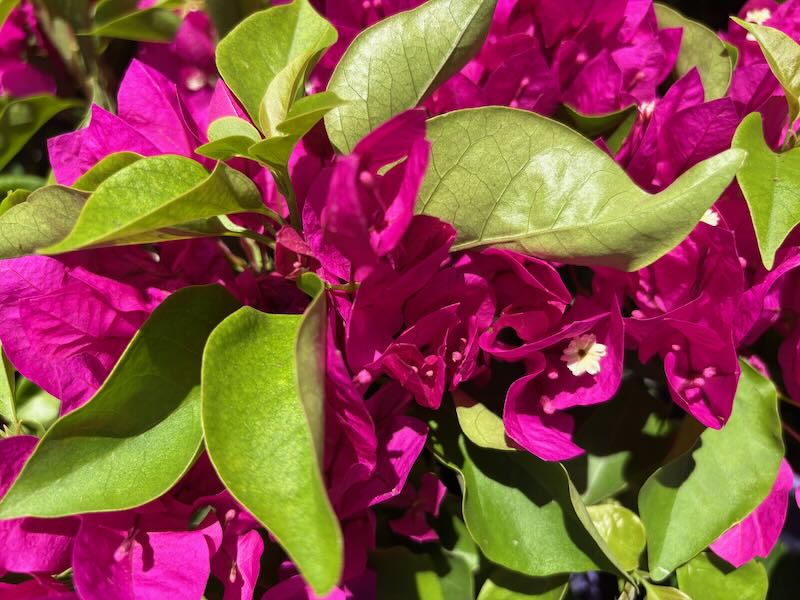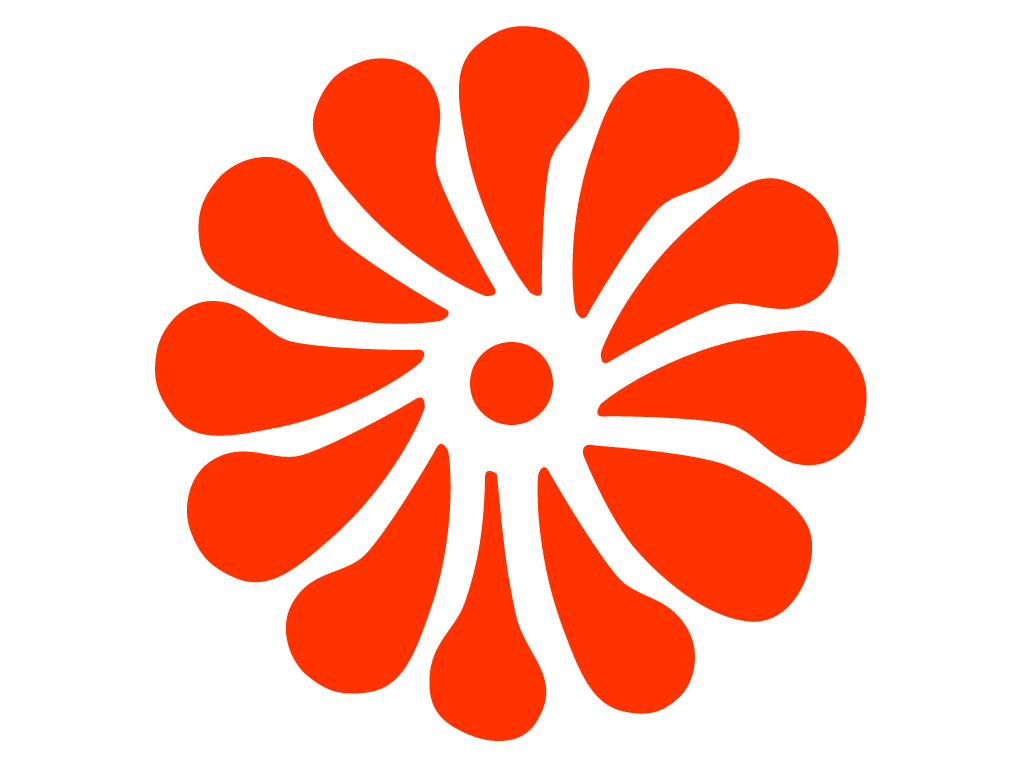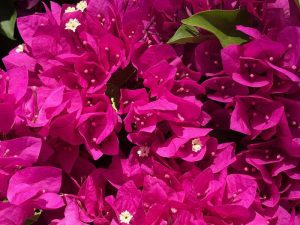Bougainvillea ‘Purple Princess‘: compact color you can train, trim, and treasure
Bougainvillea ‘Purple Princess‘ brings the drama of a full-size Paper Flower to patios, porches, and small gardens without the sprawl. This compact Bougainvillea, a member of the Nyctaginaceae (the Four O’Clock family), throws near-constant bracts in vivid magenta to violet while staying far more manageable than many vigorous selections.
You can grow Bougainvillea ‘Purple Princess’ in a large container, weave it onto a trellis, or let the canes cascade from a balcony box. The true flowers stay tiny and white at the center; the bold “petals” you admire are bracts, and they don’t quit when the weather turns hot. In warm regions you’ll see color almost year-round. In cooler zones you still get months of bloom if you give it full sun, sharp drainage, and thoughtful watering.
What makes Bougainvillea ‘Purple Princess‘ different
This cultivar earns its crown by combining heavy blooming with a tidy habit. Many Bougainvilleas bolt skyward. ‘Purple Princess’ holds to a compact, branching framework, so you can shape it without wrestling with meters of thorny cane. It thrives in heat, shrugs off wind once established, and loves reflective warmth near stucco, brick, or pavement. In containers it usually tops out around 60–120 cm (2–4 ft) tall and 60–90 cm (2–3 ft) wide; on a small trellis or fence it can reach 1.8–3 m (6–10 ft) with training. In frost-free gardens it can bloom in cycles all year. In seasonal climates it rests through winter and surges again in spring.
Family and origin
Bougainvillea hails from tropical and subtropical South America, and most garden plants are hybrids of several species. You’ll find this plant sold as Purple Bougainvillea, Purple Paper Flower, Bugambilia ‘Purple Princess’, and Bougainvillea Vine ‘Purple Princess’. All point to the same compact, magenta-bracted selection. As with every Bougainvillea, those brilliant “petals” are bracts that surround a cluster of small tubular flowers. The bracts do the heavy lifting for pollinators and for your eyes.
Bougainvillea ‘Purple Princess’ growth habit and size
Expect quick growth in warm weather. New shoots emerge green and flexible, then lignify into woody, thorned canes. Leaves are medium to dark green, slightly leathery, and ovate, typically 4–8 cm long (1.5–3 in). Bougainvillea ‘Purple Princess’ responds to pruning by branching, which means more ends for flowering. In-ground, with a light hand and a low wire or lattice, you can keep a dense mound 90–150 cm (3–5 ft) high and 120–180 cm (4–6 ft) across. Give it a vertical guide and it will climb with your help to 2–3 m (6–10 ft), still far tighter than sprawling bougainvilleas that run 6–9 m (20–30 ft).
Bougainvillea ‘Purple Princess‘ flowering season and color
Flowering ramps up when nights are a little shorter than days and the plant sits slightly on the dry side. In warm zones (USDA 9–11), bloom cycles repeat nearly all year with peaks in spring and again in autumn. In temperate gardens, color usually starts in late spring, swells in summer heat, and keeps going until cold knocks it back. The bracts glow in saturated magenta-purple with a subtle violet cast; in cooler spells they lean deeper in tone, and in very hot spells they can show a slightly redder edge. Each bracted cluster lasts for weeks, and the plant often carries both new and maturing color at once.
Landscape uses for Bougainvillea ‘Purple Princess‘
Use this selection when you crave Bougainvillea intensity but have limited space. It shines as a container “thriller” against a simple obelisk, as a “spiller” tumbling from a tall jar, or as a compact hedge along a sun-blasted fence. Train a pair on either side of a sunny doorway for a Mediterranean welcome. Let it cascade over a low wall where it can catch full sun. In coastal gardens, plant it where sea breezes sweep through—it tolerates salt spray far better than many flowering shrubs. For companions, pair with silver foliage like Helichrysum or artemisia, and mix in heat lovers such as Lantana, Portulaca, and dwarf Agave for sculptural contrast.
How to Grow Bougainvillea ‘Purple Princess‘
Light
Give Bougainvillea ‘Purple Princess’ sun, then more sun. Aim for a minimum of six hours of direct light daily. Eight or more hours produce the densest bracts and the fewest lanky shoots. In interior courtyards or coastal fog zones, site it where reflected light bounces off walls. Indoors for winter, a bright south- or west-facing window, or a sunroom, keeps it happy until spring return.
Soil
Provide fast drainage. In the ground, a lean, sandy or gravelly loam works best. If you garden on clay, amend the top 30–40 cm (12–16 in) with coarse grit and compost, then plant on a slight mound to shed winter wet. Target pH from 5.5 to 7.5; Bougainvillea tolerates slightly alkaline conditions, especially near the coast, as long as the soil drains. For containers, use a high-drainage mix: two parts quality potting soil to one part perlite or pumice, plus a part of compost for nutrition.
Watering
Water deeply, then let the root zone partly dry. That rhythm triggers flowering and prevents root issues. For new plantings, water when the top 3–5 cm (1–2 in) of soil dries, soaking to 20–25 cm (8–10 in) deep. In summer heat, containers may need a thorough drink once or twice per week; in the ground, weekly deep watering is often enough after establishment. Watch the foliage: firm leaves and bract production signal a good schedule; limp leaves by midday tell you to water that evening. Avoid frequent, shallow sips. They push soft vegetative growth at the expense of bloom.
Fertilizing
Feed lightly for flowers, not foliage. Overfeeding—especially with high nitrogen—builds leaves and long canes but starves the bracts. In spring, scratch a small handful of balanced, slow-release fertilizer around the drip line of in-ground plants, or use a half-strength liquid feed on containers every four to six weeks through midsummer. After a heavy flush, a bloom-builder with higher potassium supports the next round. Stop fertilizing six to eight weeks before your first frost to avoid tender growth.
Temperature and humidity
Heat fuels this vine. Ideal growing temperatures range from 18–32 °C (65–90 °F). Short dips to about −1 to −2 °C (30–28 °F) can nip leaves and bracts; harder or prolonged freezes can kill top growth. Plants survive reliably outdoors in USDA Zones 9–11. In Zone 8b, a sheltered microclimate and heavy winter mulch sometimes carry roots through mild winters, with regrowth in late spring. Humidity does not bother Bougainvillea if airflow stays good.
Potting and repotting
Bougainvillea ‘Purple Princess’ loves life in a pot and actually blooms best when slightly root-bound. Choose a container 35–45 cm (14–18 in) across for a young plant, with generous drainage holes. Terracotta keeps roots drier; glazed ceramic retains moisture a bit longer. Step up only one size when roots coil tightly around the root ball, usually every two to three years. When you repot, lift the plant, slice two or three vertical slits through the circling roots, and set it into fresh, gritty mix at the same depth. Water once to settle, then resume your deep-and-dry cycle.
Training, support, and pruning
This vine needs guidance rather than clinging on its own. Tie flexible canes to trellis wires, an obelisk, or a fence with soft ties spaced every 20–30 cm (8–12 in). To create a compact pillar, select three or four main canes and spiral them upward, pinching side shoots to 2–3 nodes. To maintain a low mound, pinch tips whenever a shoot reaches 20–30 cm (8–12 in); each pinch triggers branching and more flowering points.
Prune hard at the right time. Make structural cuts in late winter or very early spring before strong growth resumes. Remove dead wood, crossing canes, and any frost damage back to live tissue. Shorten remaining canes by one-third to one-half to keep the framework compact. Through the growing season, tip-prune after each big flush to encourage the next wave. Always wear gloves; thorns mean business.
Overwintering in cool climates
If your winters dip below freezing, treat ‘Purple Princess’ as a prized container specimen. Before night temperatures fall below 5 °C (41 °F), move the pot indoors to a bright, cool room. Water sparingly—just enough to keep the root ball from going bone dry. The plant may shed leaves during this rest. That’s normal. In late winter, prune to shape, refresh the top 5–7 cm (2–3 in) of potting mix, and return it outdoors once nights stay above 10 °C (50 °F).
Propagation of Bougainvillea ‘Purple Princess‘
You can propagate this cultivar by semi-ripe cuttings in late spring through midsummer. Select a non-flowering shoot about pencil thickness. Cut 10–12 cm (4–5 in) with two or three nodes, remove the lower leaves, and lightly wound the basal node. Dip in rooting hormone, then insert into a tray of 50% perlite and 50% compost. Keep bright shade, gentle bottom warmth around 21–24 °C (70–75 °F), and consistent moisture—not soggy. Rooting often takes 4–8 weeks. Pot on carefully; Bougainvillea roots dislike disturbance. For hardwood cuttings, take 15–20 cm (6–8 in) lengths in late summer, heel them into a gritty bed, and protect from frost; they callus over winter and push roots in spring.
Pests and diseases: prevention keeps color coming
Healthy, sun-drenched plants shrug off most problems. Nevertheless, stay alert. Aphids may cluster on tender tips in spring. A sharp blast of water early in the day usually clears them. Whiteflies can build in sheltered courtyards; yellow sticky cards, improved airflow, and a gentle insecticidal soap rotation help. Mealybugs hide in leaf axils on overwatered container plants; reduce water, swab with alcohol on a cotton tip, and introduce fresh air. Caterpillars and loopers sometimes chew bracts; handpick at dusk with gloves.
Fungal issues usually trace back to wet feet or shade. Root rot develops in heavy soils or saucers left full. Fix drainage and adopt the deep-and-dry routine. Leaf spot appears during long wet spells; remove spotted leaves and avoid overhead watering. Mildew is uncommon in full sun but can show up during cool, still weather; prune lightly for airflow and water the soil, not the foilage. In coastal belts, salt spray seldom harms Bougainvillea ‘Purple Princess’; rinse bracts with a gentle hose if wind deposits grit.
Environmental tolerances and site placement for Bougainvillea ‘Purple Princess‘
Heat tolerance sits high. This plant keeps blooming through 38 °C (100 °F) if soil drains and roots stay aerated. Once established in the ground, it tolerates short drought, though flowering improves with regular deep watering in extreme heat. It handles seaside gardens and mildly alkaline soils. Windbreaks help in the first season; after roots anchor, canes flex without snapping. If you garden where summer monsoons bring heavy rain, plant on a mound and mulch with gravel or coarse bark to speed drying between storms.
Bougainvillea ‘Purple Princess’ in containers on patios and balconies
For balcony gardeners, this cultivar is a gift. A 40–45 cm (16–18 in) pot, a slim trellis, and a sunny exposure create a flowering column with a footprint smaller than a side table. If your deck bakes, choose terracotta to keep roots cooler. If your site dries fast, choose glazed ceramic to extend the moisture window. Rotate the pot a quarter-turn every two weeks so all sides see the sun and bract evenly. In mixed containers, resist the urge to crowd. Give Bougainvillea ‘Purple Princess’ its own pot, then group with separate companions like Mandevilla, Plumbago, or a bowl of Portulaca so each plant gets the water it prefers.
Common problems and practical fixes
If you see lush leaves but few bracts, you’re likely overwatering or overfeeding nitrogen, or the plant lacks sun. Shift to a deep-and-dry schedule, cut nitrogen, raise potassium slightly, and move to brighter light. If bracts bleach or crisp at the edges, the pot may be too small or the plant under-watered during hot, dry winds.
Increase pot size by one step, mulch the soil surface, and water deeply in the evening before a forecast heat spike. If canes fail to flower, prune tips more often to increase branching, and avoid pinching for three to four weeks before a desired display so buds can set. If leaves yellow between veins in alkaline soil, add chelated iron as a corrective and topdress with compost to buffer pH.
Safety, thorns, and cleanup
All Bougainvilleas carry sharp thorns. Wear sturdy gloves and eye protection when pruning or tying. The sap can irritate sensitive skin; rinse if contact occurs. Fallen bracts dry papery thin and blow away easily, which makes cleanup simple on gravel and hardscape. In pools, skim promptly—they float but can stain if left to break down.
Design pairings that flatter ‘Purple Princess‘
Lean into Mediterranean style with limestone, clay pots, and silver foliage. Let the magenta-purple bracts sit against white stucco for maximum pop. For a tropical vignette, pair with variegated Hibiscus in a nearby pot and underplant with lime-green sweet potato vine. In cottage borders, weave a pair of Bougainvillea ‘Purple Princess’ standards among Salvia, Gaura, and Verbena bonariensis for height and movement. At the coast, combine with Westringia, Alyogyne, and low mounds of Lomandra for a wind-tolerant, salt-brushed palette.
Prop a small standard or espalier
If you want a flowering lollipop, stake a single strong cane and remove lower side shoots for 60–90 cm (24–36 in). Pinch the head to form a rounded crown and keep it clipped after each bloom cycle. For a fan against a fence, stretch horizontal wires 30 cm (12 in) apart. Tie young shoots to the lower wire, then train new shoots upward, fanning them and pinching to fill space. Both forms suit Bougainvillea ‘Purple Princess’ because it branches easily under light pruning.
Why gardeners choose Bougainvillea ‘Purple Princess‘
In a word, reliability. Bougainvillea ‘Purple Princess’ turns relentless sun and reflected heat into saturated color, then keeps delivering with minimal fuss. It offers the bougainvillea look in spaces where larger cultivars overwhelm. And, it performs in containers without sulking. It forgives a missed watering and forgives a hard prune. And it rewards good siting and simple routines with bloom after bloom, from the first warm weeks of spring until frost.
Final care checklist
Plant it where sun is strongest. Use fast-draining soil and a container with big drainage holes if you garden on a patio. Water deeply, then let the mix partly dry. Feed modestly. Prune with confidence after each flush. Protect from freezes, and overwinter bright and cool if you live north of USDA Zone 9. Do those few things, and Bougainvillea ‘Purple Princess’ will act like the compact, ever-blooming princess its name promises—ruling your sunny space with a rich, purple crown.



